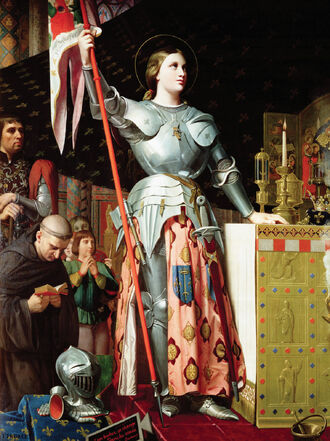
La Pucelle
Joan of Arc was a peasant girl who rose from obscurity to lead the French army to several victories during the Hundred Years War, leading to the coronation of Charles VII as the French king -- she did not personally kill anyone, but carried a battle standard and led the army, as well as making tactical decisions. She was born about 1412, and starting at age twelve claimed to see visions of and hear the voices of Saints Catherine, Michael, and Margaret (one of the less understood aspects of her life -- either she was lying, or she was mentally ill in some way, or God really was telling her to drive out the English, the reader can draw their own conclusions without stating them here), who she said told her to drive out the English and bring Charles VII to Rheims, then under English control, for his coronation.
After gaining the approval of Charles and a theological commission, she arrived at the siege of Orleans in 1429, where at the age of 17 she led the French to victory; contemporaries acknowledged her as the heroine of the engagement after she was wounded in the neck by an arrow but returned to lead the final charge. She led the French to several other victories, including at Reims, and was present at Charles VII's coronation. In October, Joan took Saint-Pierre-le-Moûtier and was granted nobility.
However, a risky skirmish on 23 May 1430 led to her capture. Her family were peasants and did not have the money to ransom her, and King Charles VII, despite her winning several battles that strengthened his claim to the crown, refused to intervene. She attempted several escapes, but all failed. The Duke of Burgundy, who actually held much of France under English control, wanted his nephew King Henry VI to be recognized as the legitimate king of France; therefore Joan's victories had put a major crimp in his plans. Formal religion was still very strong during this time, and painting Joan as a heretic helped to cast aspersions on Charles VII's hold on the crown. Perhaps unsurprisingly, she was tried and convicted of heresy by a pro-Burgundy court, and forced to sign a renunciation of heresy she did not understand because she was illiterate. Heresy was a capital crime only for a repeat offense; she promised not to wear male clothing, which was considered heretical, but resumed it either as a defense against rape or, in the testimony of Jean Massieu, because her dress had been stolen and she was left with nothing else to wear. In any case, the church court rejected her supporters' explanations, and she was burned at the stake in 1431. In 1456 her conviction was posthumously reversed, and in 1920 she was declared a Catholic saint.
There are more churches and shrines dedicated to her in England than in France. She also is often painted in a Battle Ballgown.
Her fame also made writers base characters on her, thus the Jeanne D Archetype.
For further information, see the book Joan of Arc: The Warrior Saint, by Stephen W. Richey. For a famous fictional portrayal, there is George Bernard Shaw's play Joan of Arc which fictionalises large amounts of the story and actually seems to make an attempt to redeem her accusers.
Tropes Relating to Joan of Arc
- Action Girl
- Alternate Character Interpretation: Joan's Voices have been seen as either the result of a genuine religious experience, schizophrenia, or drugs.
- Badass Pacifist: In her trial, Joan claimed to never have killed anyone on the battlefield, saying she preferred her banner over her sword.
- Chaste Heroine: Joan used her virginity as a sign of her purity, and as such remained chaste all her life. Two tests were performed to confirm her virginity, including one during her trial, thus confirming it.
- Deadpan Snarker: If her trial records are anything to go by, Joan was this, even delivering a Take That to the heavily-accented judge Seguin Seguin:
Seguin Seguin: What language did [the Voices] speak? |
- Historical Villain Upgrade: See Shakespeare's portrayal of her.
- Jeanne D Archetype: Trope Maker, Trope Codifier and Trope Namer.
- Kangaroo Court: Joan's trial was headed by Bishop Pierre Cauchon, who was in the payroll of both the English Earl of Warwick and the Duke of Burgundy, and handpicked the judges himself from members of the University of Paris who also hated Joan's guts. She never really stood a chance.
- Lady of War: Probably one of the more obvious examples.
- My God, What Have I Done?: Her executioner, Geoffrey Therage, believed that he had damned himself irredeemably by burning her.
- A possible example may be Cardinal Henry Beaufort, the overseer of the trial,who left the execution in tears.
- Several of her judges, like John de Stogumber and Nicolas Loiseleur, seemed to feel some remorse after her execution.
- Redheaded Hero: Despite the fact that no portrait of her made while she was alive exists, she is frequently portrayed in the media with red hair.
- Thou Shall Not Kill: According to herself during her trial, she followed this.
- Savvy Guy, Energetic Girl:Charles VII and Joan of Arc.
- Sweet Polly Oliver: She didn't really disguised herself as a man, but she did wear male clothing for practical reasons.
